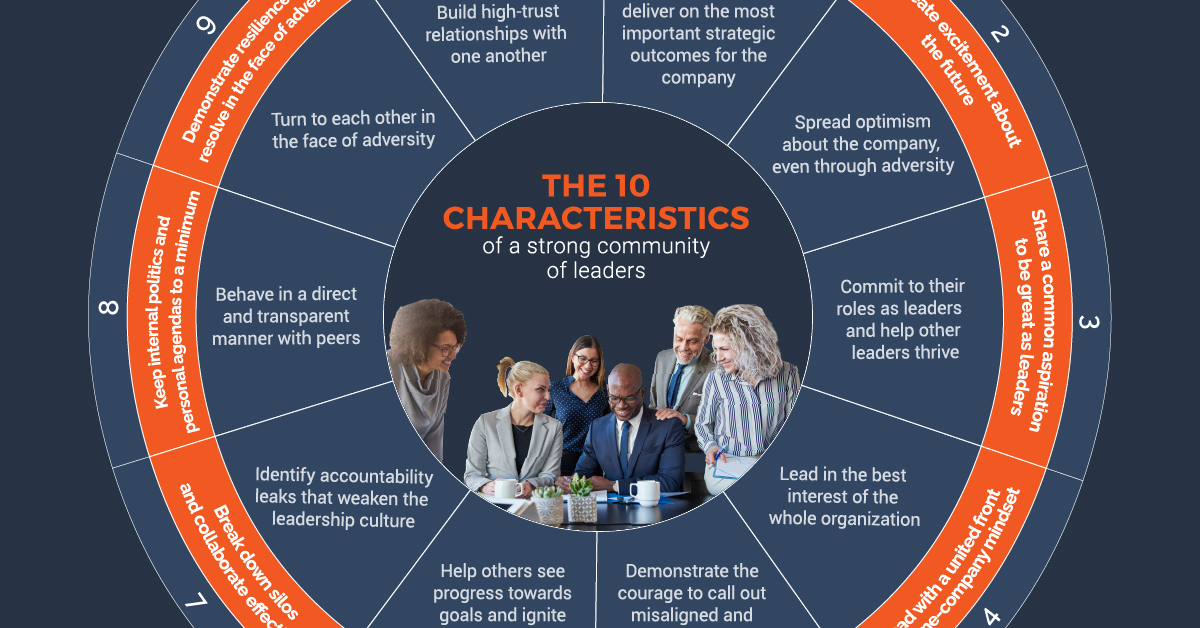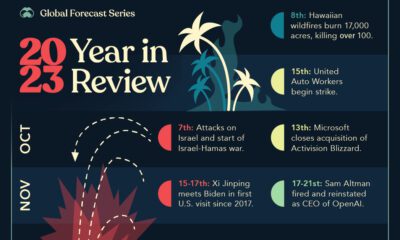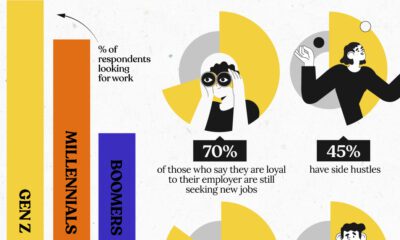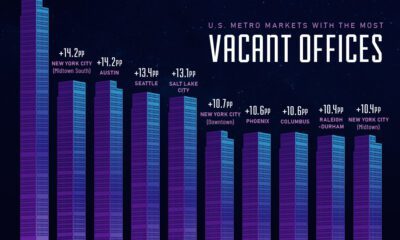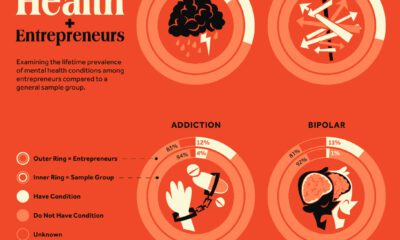Misc
10 Ways You Can Build Leadership Communities in a Hybrid World of Work
The world has never been more connected. Yet many of us feel more disconnected than ever before.
In particular, CEOs and managers can often feel isolated from their peers, and therefore crave a greater sense of community and belonging. This lack of social connection can have a detrimental impact on both them and their team—putting the future of their company at risk.
Leading in a Hybrid World of Work
This infographic from bestselling author Vince Molinaro dives into the ways you can build a strong community of leaders in your organization, enabling you to more successfully execute on strategy, drive growth, and deliver results.

>>Download Dr.Vince Molinaro’s Community Builder Ebook Today
The Critical Need for Leadership Communities
In today’s world, many leaders have been conditioned to work and lead in a way that is individualistic and hyper-competitive, which leads to problematic outcomes including:
- Limiting innovative ideas
- Causing overwhelm and stress
- Limiting diversity and a sense of inclusion
- Promoting a macho culture
- Creating heroes and zeros in organizations
This outdated model breeds a weak leadership culture. Even though leadership expectations are higher than ever, very few companies boast a strong leadership culture. In fact, just 15% of companies have the culture they need to succeed.
What does a weak leadership look like?
Weak Leadership Cultures
When leaders demonstrate the following behaviors, organizations are at risk of developing a weak leadership culture:
- They lack clarity around strategic priorities.
- They fail to inspire the people they lead.
- They tolerate ineffective and mediocre leadership.
- They demonstrate animosity for the success of other leads, teams, and departments.
- They work at cross-purposes with each other.
- They prop themselves up while downplaying the contribution of others.
- They don’t engage stakeholders.
- They regularly badmouth others and throw colleagues under the bus.
- They withhold information as a way to retain power over their peers.
- They act as bystanders when colleagues need help.
When these negative dynamics become apparent, organizations pay a significant price. According to a report from Qualtrics, 40% of managers see a decline in their mental health, while another study shows that 66% of leaders have checked out entirely.
It is clear that building a strong community of leaders has become critical as the world continues to become even more complex and uncertain. Let’s dive into some of the ways you can build a greater sense of belonging in your organization today.
The Characteristics of Leadership Communities
Here are the 10 characteristics and behaviors that promote a strong community of leaders. Does this describe your organization’s leadership culture?
| Characteristic | Aligned Behavior |
|---|---|
| 1. Have clarity on the strategic direction of the organization | Be determined to deliver on the most important strategic outcomes for the company |
| 2. Create excitement about the future | Spread optimism about the company, even through adversity |
| 3. Share a common aspiration to be great as leaders | Commit to their roles as leaders and help other leaders thrive |
| 4. Lead with a united front and a one-company mindset | Lead in the best interest of the whole organization |
| 5. Hold each other accountable by calling out unproductive leadership behavior | Demonstrate the courage to call out misaligned and unacceptable behaviors |
| 6. Celebrate success and key milestones | Ignite passion by recognizing others and showing progress towards goals |
| 7. Break down silos and collaborate effectively | Identify accountability gaps that weaken the leadership culture |
| 8. Keep internal politics and personal agendas to a minimum | Behave in a direct and transparent manner with peers |
| 9. Demonstrate resilience and resolve in the face of adversity | Turn to each other while navigating tough challenges |
| 10. Support one another and have each other’s backs | Build high-trust relationships with one another |
Most leaders want to be in an environment where there is real clarity, alignment, commitment, and mutual support—it just takes one accountable leader to make it happen.
The Benefits to Creating a Strong Community of Leaders
If done right, the effects of building a strong community of leaders can be extraordinary:
- Promotes a stronger sense of belonging.
- Allows for greater knowledge sharing.
- Encourages higher levels of performance.
- Creates a culture of accountability.
- Improves employee engagement.
Moreover, research shows that employee engagement is directly linked to a company’s culture and value system. In fact, employee engagement levels can reach up to 72% when managers work well with each other.
With the working world transforming before our very eyes, it’s time to establish a new leadership contract so that CEOs and managers can lead their organizations successfully into the future.
Do you have what it takes to be a community builder? Download your Ebook to discover practical strategies you can apply today.
VC+
VC+: Get Our Key Takeaways From the IMF’s World Economic Outlook
A sneak preview of the exclusive VC+ Special Dispatch—your shortcut to understanding IMF’s World Economic Outlook report.

Have you read IMF’s latest World Economic Outlook yet? At a daunting 202 pages, we don’t blame you if it’s still on your to-do list.
But don’t worry, you don’t need to read the whole April release, because we’ve already done the hard work for you.
To save you time and effort, the Visual Capitalist team has compiled a visual analysis of everything you need to know from the report—and our VC+ Special Dispatch is available exclusively to VC+ members. All you need to do is log into the VC+ Archive.
If you’re not already subscribed to VC+, make sure you sign up now to access the full analysis of the IMF report, and more (we release similar deep dives every week).
For now, here’s what VC+ members get to see.
Your Shortcut to Understanding IMF’s World Economic Outlook
With long and short-term growth prospects declining for many countries around the world, this Special Dispatch offers a visual analysis of the key figures and takeaways from the IMF’s report including:
- The global decline in economic growth forecasts
- Real GDP growth and inflation forecasts for major nations in 2024
- When interest rate cuts will happen and interest rate forecasts
- How debt-to-GDP ratios have changed since 2000
- And much more!
Get the Full Breakdown in the Next VC+ Special Dispatch
VC+ members can access the full Special Dispatch by logging into the VC+ Archive, where you can also check out previous releases.
Make sure you join VC+ now to see exclusive charts and the full analysis of key takeaways from IMF’s World Economic Outlook.
Don’t miss out. Become a VC+ member today.
What You Get When You Become a VC+ Member
VC+ is Visual Capitalist’s premium subscription. As a member, you’ll get the following:
- Special Dispatches: Deep dive visual briefings on crucial reports and global trends
- Markets This Month: A snappy summary of the state of the markets and what to look out for
- The Trendline: Weekly curation of the best visualizations from across the globe
- Global Forecast Series: Our flagship annual report that covers everything you need to know related to the economy, markets, geopolitics, and the latest tech trends
- VC+ Archive: Hundreds of previously released VC+ briefings and reports that you’ve been missing out on, all in one dedicated hub
You can get all of the above, and more, by joining VC+ today.
-

 Energy1 week ago
Energy1 week agoThe World’s Biggest Nuclear Energy Producers
-

 Money2 weeks ago
Money2 weeks agoWhich States Have the Highest Minimum Wage in America?
-

 Technology2 weeks ago
Technology2 weeks agoRanked: Semiconductor Companies by Industry Revenue Share
-

 Markets2 weeks ago
Markets2 weeks agoRanked: The World’s Top Flight Routes, by Revenue
-

 Countries2 weeks ago
Countries2 weeks agoPopulation Projections: The World’s 6 Largest Countries in 2075
-

 Markets2 weeks ago
Markets2 weeks agoThe Top 10 States by Real GDP Growth in 2023
-

 Demographics2 weeks ago
Demographics2 weeks agoThe Smallest Gender Wage Gaps in OECD Countries
-

 United States2 weeks ago
United States2 weeks agoWhere U.S. Inflation Hit the Hardest in March 2024
